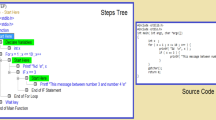Abstract
In the last few years, the rapid decline of computing costs, coupled with the sharp increase of personal computers and “canned” software, has expanded dramatically the population of the computer user community. More and more people today are using computers. However, to many people, the usefulness of a computer is bounded by the usefulness of the canned application software available for the computer. Application programs written for a mass audience seldom give every user all the capabilities that he/she needs. Those who wish to use the computer to do something beyond the capabilities of the canned programs discover that they have to “program.”
Access this chapter
Tax calculation will be finalised at checkout
Purchases are for personal use only
Preview
Unable to display preview. Download preview PDF.
Similar content being viewed by others
References
L. A. Belady, and K. Hosokawa, Visualization of independence and dependence for program concurrency, Proceedings of the 1984 IEEE Computer Society Workshop on Visual Languages, Hiroshima, Japan, 1984, pp. 59–63.
G. D. Brown and D. H. Sefton, The micro vs. the applications logjam, Datamation (Jan., 96–104 (1984).
G. P. Brown, R. T. Carling, C. F. Herot, D. A. Kramlich, and P. Souza, Program visualization: Graphical support for software development, IEEE Comput. 18 (8), 27–35 (1985).
S. K. Chang, Image information systems, Proc. IEEE 73 (4), 754–764 (1985).
S. K. Chang, J. Reuss, and B. H. Mccormick, Design considerations of a pictorial database system, Int. J. Policy Anal. Inf. Syst. 1 (2), 49–70 (1978).
J. L. Diaz-Herrera and R. C. Flude, Pascal/HSD: A graphical programming system, Proceedings of Compsac 80, IEEE Computer Society Press, Los Alamitos, California, 1980, pp. 723–728.
W. Finzer and L. Gould, Programming by rehearsal, Byte 9 (6), 187 - 210 (1984).
E. P. Glinert and S. L. Tanimoto, Pict: An interactive graphical programming environment, IEEE Comput. 17 (11), 7–25 (1984).
R. B. Grafton and T. Ichikawa, Guest editor’s Introduction to the special issue on Visual Programming, IEEE Comput. 18 (8) 6–9 (1985).
C. F. Herot, Spatial management of data, ACM Trans. Database Syst. 5 (4), 493–514 (1980).
C. F. Herot, G. P. Brown, R. T. Carling, M. Friedell, D. Kramlich, and R. M. Baecker, An integrated environment for program visualization, in Automated Tools for Information System Design, edited by Schneider and Wasserman (Eds.), North-Holland, Amsterdam, 1982, pp. 237–259.
R. J. K. Jacob, A state transition diagram language for visual programming, IEEE Comput. 18 (8), 51–59 (1985).
H. kitagawa, M. Gotoh, S. Misaki, and M. Azuma, Form document management system SPECDOQ—Its architecture and implementation, Proceedings of the Second ACM Conference on Office Information Systems, June 1984, pp. 132–142.
F. Lakin, Spatial parsing for visual languages, Chapter 3 of this book.
D. Luo, and S. B. Yao, Form operation by example—A language for office information processing, Proceedings of Sigmod Conference, June 1981, pp. 213–223.
N. Monden, Y. Yoshino, M. Hirakawa, M. Tanake, and T. Ichikawa, HI-Visual: A language supporting visual interaction in programming, Proceedings of the 1984 IEEE Computer Society Workshop on Visual Languages, Hiroshima, Japan, 1984, pp. 199–205.
M. C. Pong, and N. NG, Pigs—A system for programming with interactive graphical support, Software Practice Experience 13 (9), 847–855 (1983).
R. Purvy, J. Farrell, and P. Klose, The design of Star’s records processing: Data processing for the noncomputer professional, ACM Trans. Office Inf. Syst. 1 (1), 3–24 (1983).
G. Raeder, A survey of current graphical programming techniques, IEEE Comput. 18 (8) 11–25 (1985).
G. Raeder, Programming in pictures, Ph.D. dissertation, University of Southern California, Los Angeles, November 1984 (Technical Report TR-84-318, USC, or Technical Report 8–85, Norweigian Institute of Technology).
S. P. Reiss, Pecan: Program development systems that support multiple views, IEEE Trans. Software Eng. 11 (3) 276–285 (1985).
N. Roussopoulos and D. Leifker, An introduction to PSQL: A pictorial structured query language, Proceedings of the 1984 IEEE Computer Society Workshop on Visual Languages, Hiroshima, Japan, 1984, pp. 77–87.
N. C. Shu, Formal: A forms-oriented and visual-directed application system, IEEE Comput. 18 (8), 38–49 (1985).
D. C. Smith, Pygmalion: A creative programming environment, Ph.D. thesis, Department of Computer Science, Stanford University, 1975, Technical Report No. STAN-CS-75- 499.
D. C. Smith, C. Irby, and R. Kimball, The star user interface: An overview, Proceedings of National Computer Conference, 1982, pp. 515–528.
S. B. Yao, A.R. Hevner, Z. Shi, and D. Luo, Formanager: An office forms management system, ACM Trans. Office Inf. Syst. 2 (3), 235–262 (1984).
M. M. Zloof, QBE/OBE: A language for office and business automation, Computer May, 13–22 (1981).
Author information
Authors and Affiliations
Editor information
Editors and Affiliations
Rights and permissions
Copyright information
© 1986 Plenum Press, New York
About this chapter
Cite this chapter
Shu, N.C. (1986). Visual Programming Languages: A Perspective and a Dimensional Analysis. In: Chang, SK., Ichikawa, T., Ligomenides, P.A. (eds) Visual Languages. Management and Information Systems. Springer, Boston, MA. https://doi.org/10.1007/978-1-4613-1805-7_2
Download citation
DOI: https://doi.org/10.1007/978-1-4613-1805-7_2
Publisher Name: Springer, Boston, MA
Print ISBN: 978-1-4612-9010-0
Online ISBN: 978-1-4613-1805-7
eBook Packages: Springer Book Archive




